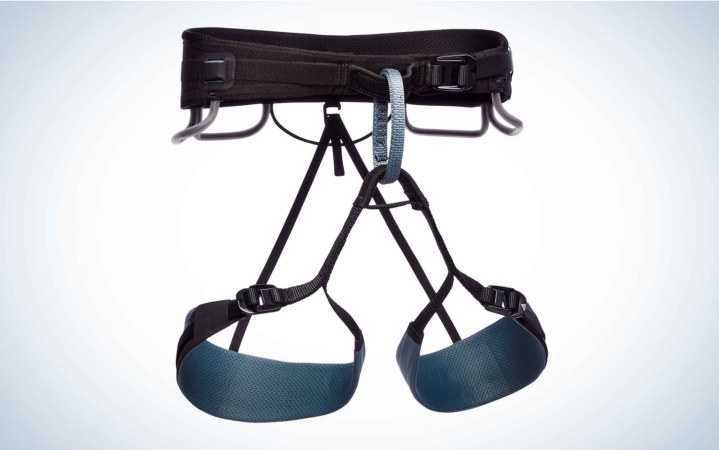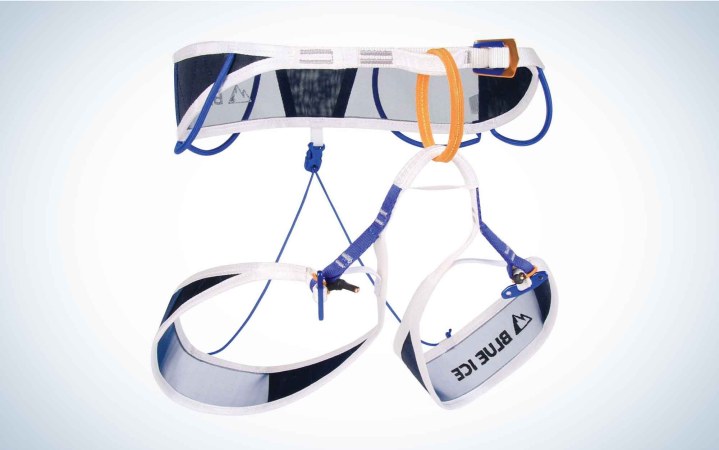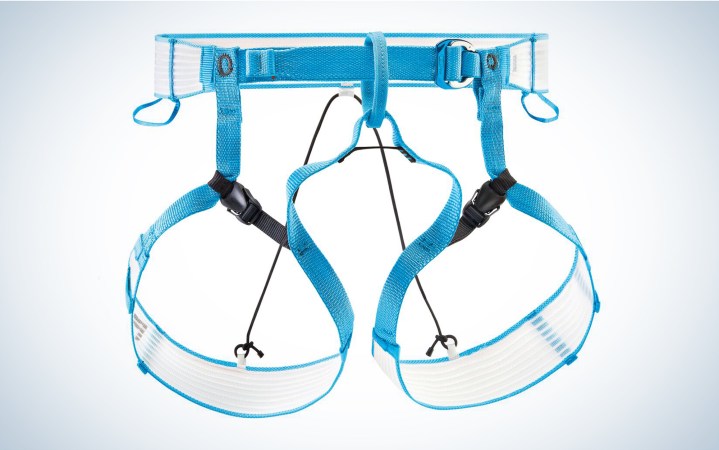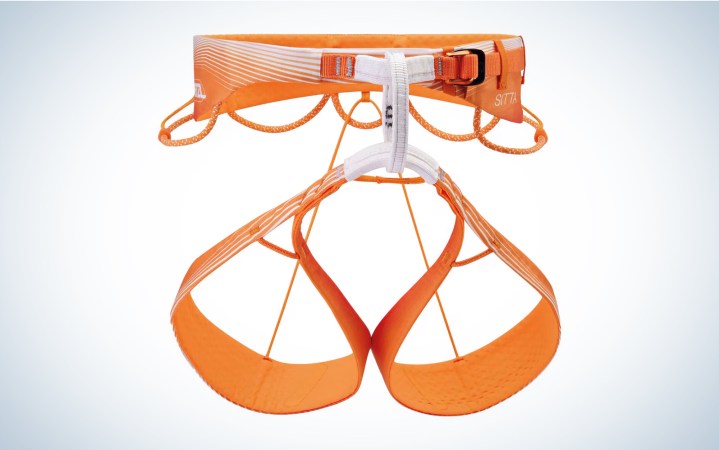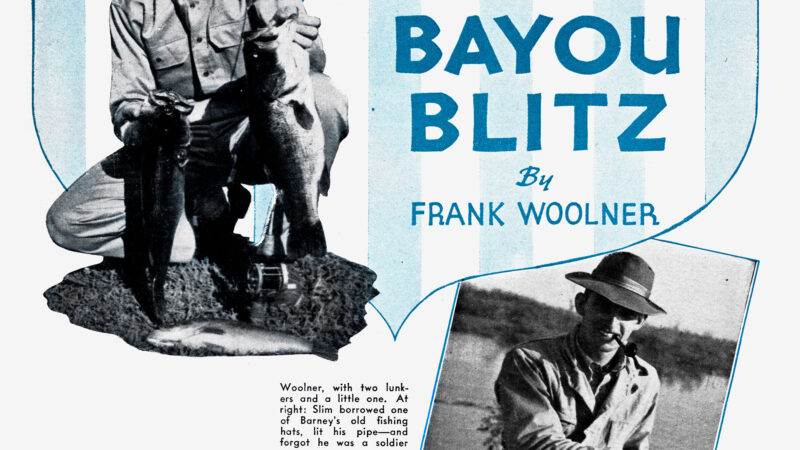The Best Climbing Harnesses of 2024, Tested and Reviewed
We may earn revenue from the products available on this page and participate in affiliate programs. Learn More ›
A climbing harness is one of the few pieces of gear that is absolutely essential when attempting to scale anything that stretches beyond bouldering height. Maybe you don’t feel that way if you’re Alex Honnold, but I suppose every rule has it’s exception. For most of us who like to travel in the vertical world, we use a rope to catch us in the event of a fall and the rope ties into a harness. Obviously, the most important trait of a harness is that it be strong enough to hold a fall. Luckily, reputable manufacturers produce harnesses that meet UIAA standards so climbers can sleep easy at night regarding strength and standards.
This allows us to be a little more picky when it comes to the less consequential bells and whistles that a harness might feature. There are all kinds of harness styles on the market these days — some highly specialized, and some claiming to be the best at everything. Through testing these harnesses, I drilled down to the details to find what features make these the best climbing harnesses and the ideal application for each style.
- Best Overall: Black Diamond Technician
- Best for Technical Alpine Climbing: Blue Ice Choucas Pro
- Best for Mountaineering: Petzl Altitude
- Best for Projecting: Arc’teryx AR-395a
- Best For Multi-Pitch: Petzl Sitta
How I Tested the Best Climbing Harnesses
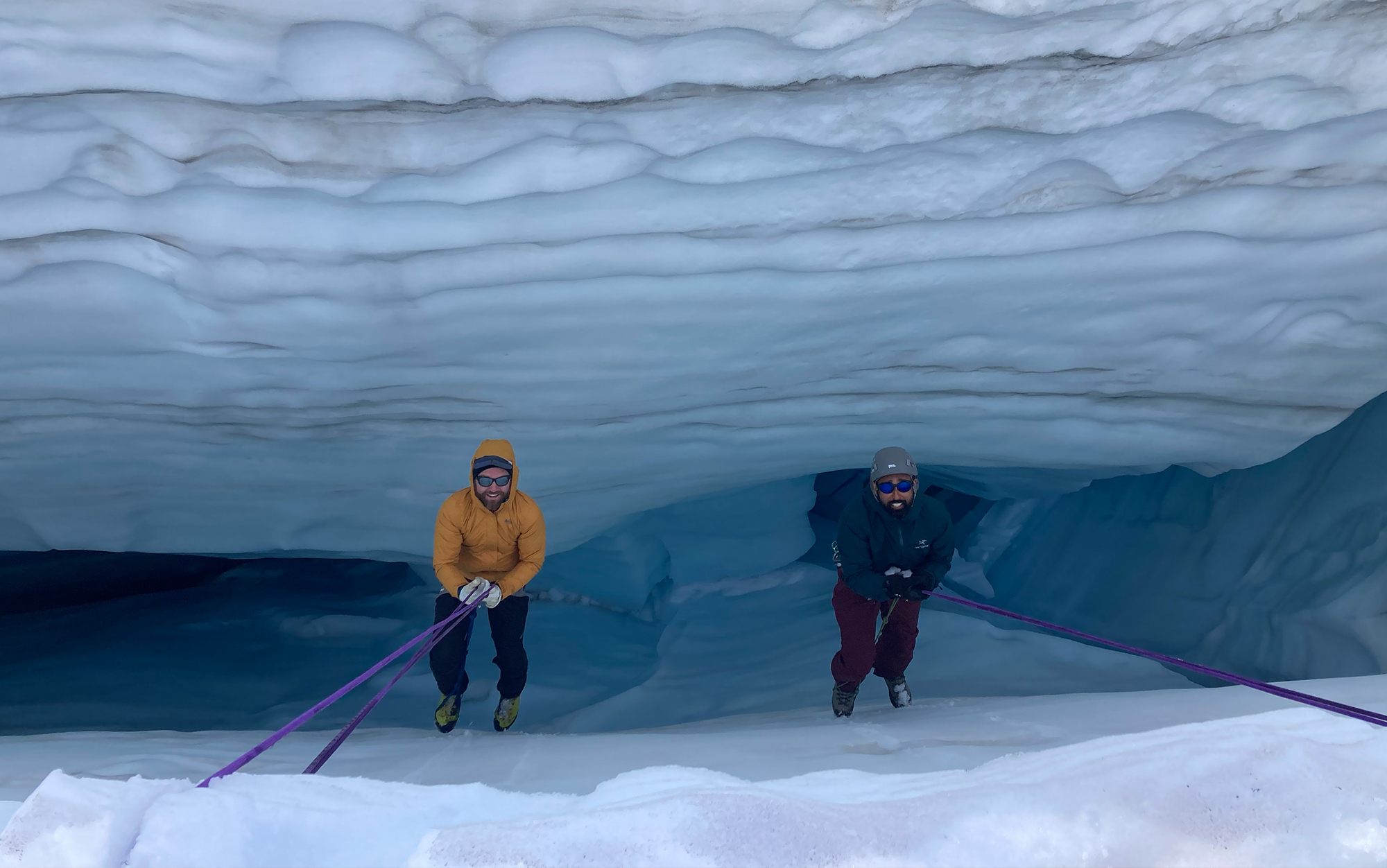
Sean McNally
To test these harnesses, I took them climbing. I’ve used most of these harnesses for years over my climbing and guiding career, putting them to the test on glaciers, alpine ice, desert crack climbing, overhanging limestone, and alpine granite. While testing for this review, I revisited some updated favorites and a few new styles with an eye towards some specific details:
Comfort while Hanging or Falling
Falling is always a possibility when you go climbing. That’s why we wear the harness in the first place. Falling might be more or less likely depending on what type of climbing you’re doing but when it happens, it’s nice to be caught on a cushy harness. I took lead falls in every one of these harnesses except for the ones that weren’t designed for routinely taking big sport whippers. For those, I assessed the comfort while performing a loaded task like crevasse rescue or hanging on rappel.
Weight
When it comes to climbing, weight matters. The less weight you have on you, the easier it’ll be to climb. But it isn’t always as simple as grabbing the lightest harness every time. Depending on the type of climbing you’re doing, there are times when you trade grams for utility. I tried to find the right balance between light and functional designs for each type of climbing considered here. I independently weighed the two ultralight harnesses, which is the weight listed in the Blue Ice Choucas Pro and Petzl Altitude specifications.
Packability
This is often an underrated aspect of a harness. Harnesses are a weird shape with a bunch of loops and stringy things apt to get caught on everything when you try to pull it out of your pack. My test for packability has always been: Can I roll it up and fit it in my helmet? A harness stuffed in your helmet saves space in your pack and works well as you’ll likely don them both at the same time.
Special Features
Harnesses share a lot of common features such as belay loops, gear loops, and riser straps — but some have specific tweaks to optimize them for certain types of climbing. Slots for ice clippers, creative buckle designs, and strategically padded areas are just a few examples of features that manufacturers use to tailor their harnesses to certain types of climbers.
Best Climbing Harnesses: Reviews & Recommendations
Best Overall: Black Diamond Technician
Key Features
- 376 g
- Releasable riser straps
- Adjustable leg loops
- Four ice clipper slots
Pros
- Very comfortable hanging or falling
- Surprisingly low profile for its versatility
- Doesn’t inhibit climbing movement
Cons
- Hard to put on while wearing crampons
The Black Diamond Technician Harness is the ultimate all-arounder. I find myself reaching for this harness more than any other when I’m climbing in fifth class terrain. I’ve taken whippers all day in this harness while working on a project, taken it up alpine snow and ice couloirs in Alaska, and everything in between, and the Technician hasn’t left me wanting much more.
While it isn’t an ultralight harness, the Technician is stripped down to the absolute minimum while maintaining enough specialty features and fabric to be comfortable and functional for all types of climbing. If folded and rolled up carefully, the harness fits into a helmet nicely, making it an easy item to pack and bring along.

Sean McNally
This harness features four slots for ice clippers, so you can split up your long and short ice screws on each side while climbing vertical ice. This eliminates futzing around finding the appropriate screw size when your fingers are cold and you’re racing the pump clock hanging from a tool. It also has fully adjustable waist and leg loops so dialing in a comfortable fit isn’t an issue. Lastly, the elastic riser straps in the back can be unclipped so when nature calls and you’ve gotta drop trou in the middle of a long climb, there’s no need to take the harness off (just be very careful while doing your business).
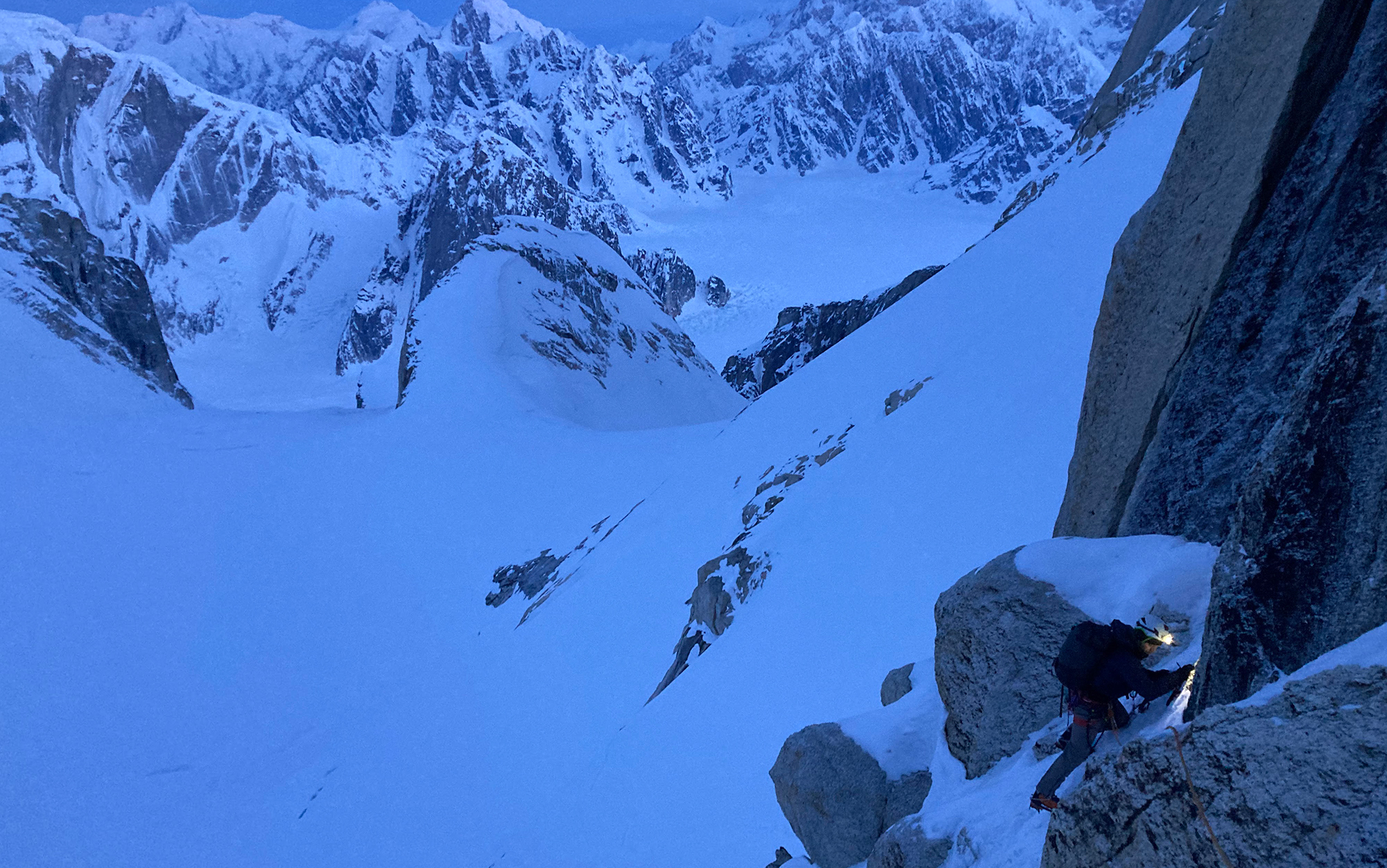
Sean McNally
The only thing I can say that isn’t ideal about this harness is that it is a bit difficult to put on if you’re wearing crampons. You can undo all the buckles and riser straps and redo them around yourself while standing, but it’s a pain to do with gloves on and not quite worth the effort.
Time and time again, this harness has impressed me no matter the climbing objective. If you’re looking for a quiver of one in the harness department, look no further than the Black Diamond Technician.
Read Next: Best Crampons
Best for Technical Alpine Climbing: Blue Ice Choucas Pro
Key Features
- 178 g (measured men’s large)
- Mesh polyethylene waist and leg loops
- Releasable leg loops
- Four ice clipper slots
- Four gear loops
Pros
- Super light and packable
- Can put it on easily while wearing crampons
- Works as a mountaineering and technical climbing harness
Cons
- Not very comfortable to hang in
- Leg loop toggles can be tough to work with gloves
I’ll admit that when the Blue Ice Choucas Pro harnesses started popping up on all the guides in the North Cascades, I was a bit skeptical, suspecting a fad. It looks like someone took a streamlined mountaineering harness and added a bunch of technical climbing features like gear loops and ice clipper slots to make it a crossover. A rule of thumb with gear is if something tries too hard to do two things, it usually doesn’t do either thing very well. But I tip my cap to the folks at Blue Ice as they have created a mountaineering harness that functions elegantly as a technical alpine climbing harness as well.

Sean McNally
The harness features four ice clipper slots and four gear loops so you can take a full alpine rack with you on the climb. The mesh polyethylene waist and leg loops keeps it in the weight range of a minimalist mountaineering harness. Blue Ice’s website lists the weight as 146 grams but I clocked mine in at 178 grams on a home kitchen scale. The lightweight construction makes the Choucas Pro extremely packable; you could probably fit two of them in the same helmet.
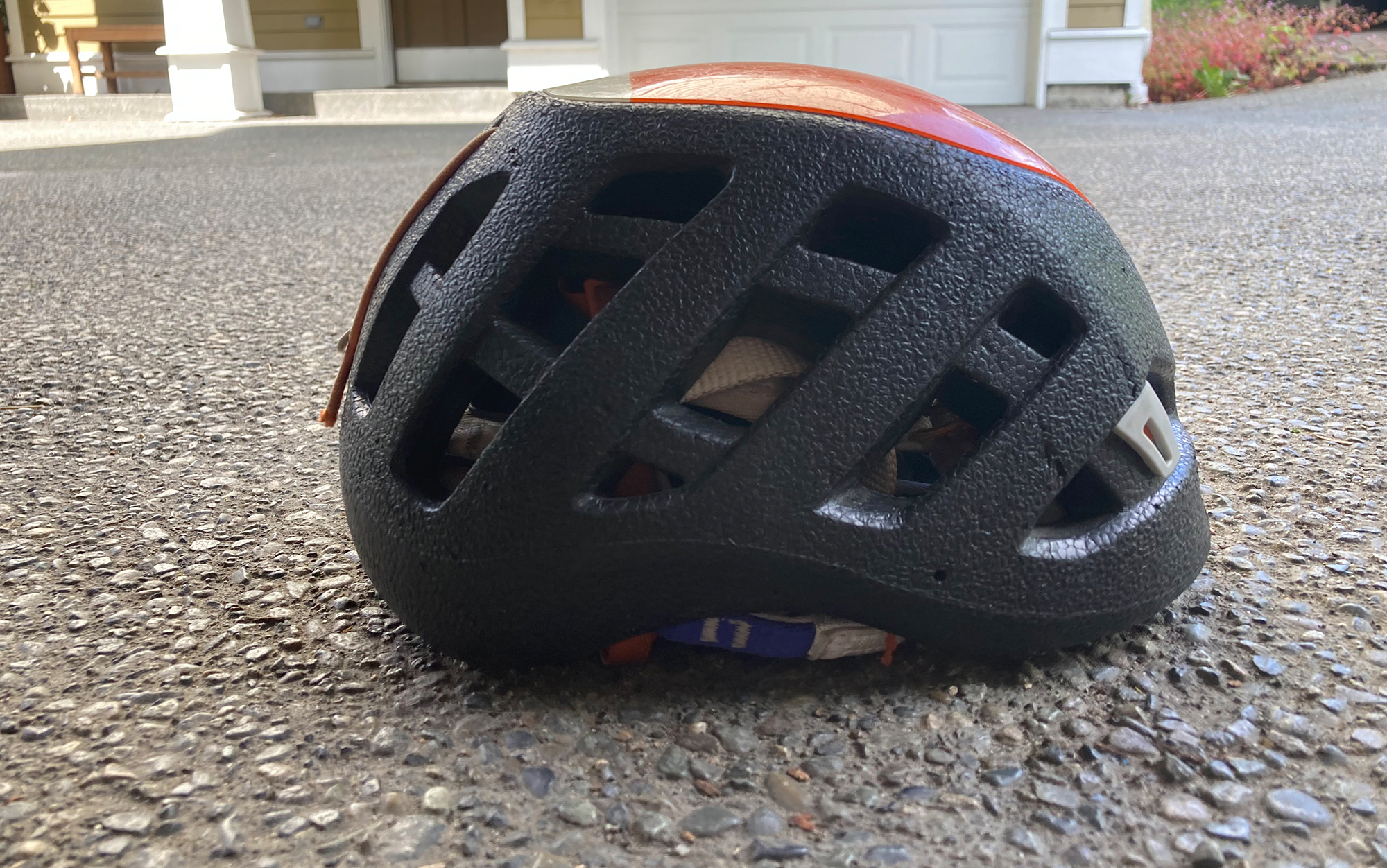
Sean McNally
Unsurprisingly, the Choucas Pro is not a super comfortable harness to hang around in. I’ve used it rappelling and in crevasse rescue situations so it will get the job done, but don’t expect your thighs or groin to love the experience.
Best for Mountaineering: Petzl Altitude
Key Features
- 160g (measured men’s large)
- High Modulus Polyethylene waist and leg loops
- Releasable leg loops
- Two gear loops
- Ice screw retainers on leg loops
Pros
- Very packable
- Lightweight
- Simple design
- Easy to put on with crampons and gloves
Cons
- Not comfortable to hang in
- Specialized for mountaineering only
No muss. No fuss. Just something to keep you attached to a rope in case of emergency. When mountaineering, you just want to put a harness on and then forget that it’s there. The Petzl Altitude was designed with just that in mind.
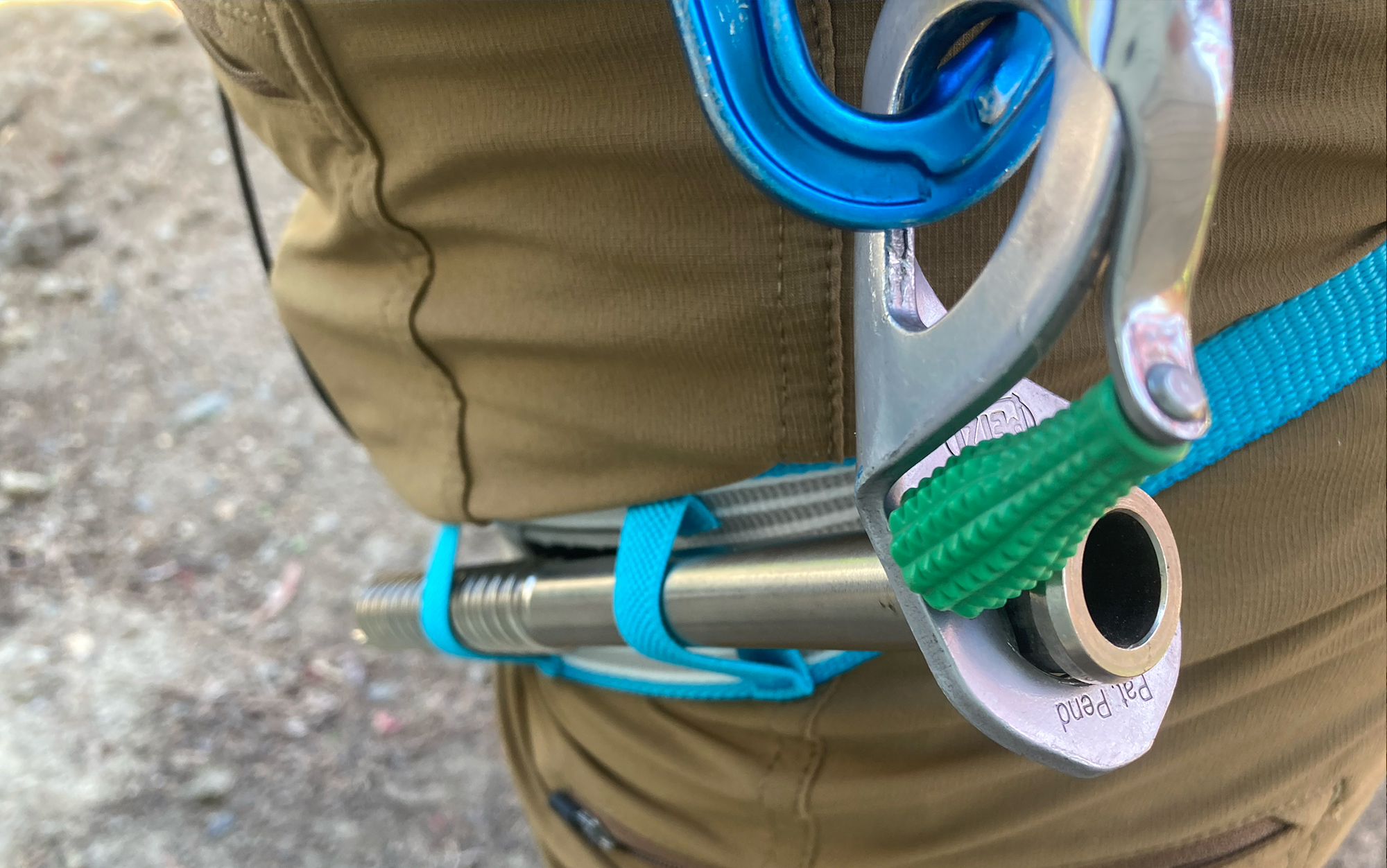
Sean McNally
The Altitude is a stripped-down minimalist mountaineering harness that doesn’t weigh much and packs down to almost nothing so you can stuff it anywhere you like. The two strings that act as gear loops allow just enough carrying capacity for a crevasse rescue kit. There’s an ice screw retainer on each leg loop; you can add one or two screws to that without them flopping around.
The best part of the Altitude’s design is how easily you can put it on while wearing crampons. The leg loop buckles are easy to work while wearing gloves so the transition to getting roped up can happen almost anywhere and with minimal effort or discomfort.
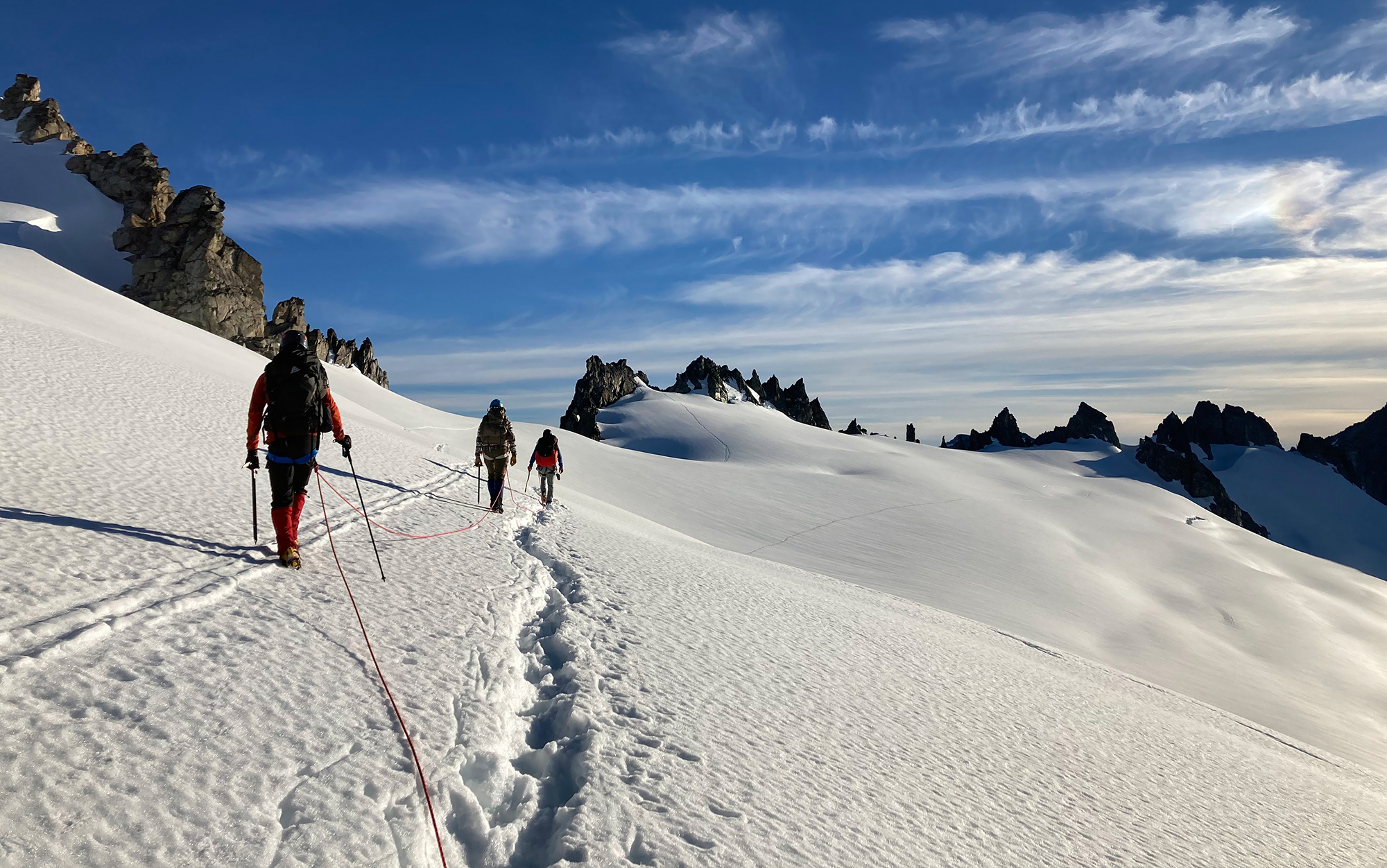
Sean McNally
I wouldn’t recommend bringing this harness if you plan to spend a bunch of time hanging in it. During crevasse rescue practice I have been both the rescuer and victim in this harness and while it performs the basic function, it’s not comfortable. I’ve also used this harness for short periods of rappelling but if a route calls for anything more than four rappels, I’m usually reaching for the Blue Ice Choucas Pro or Black Diamond Technician.
Best for Projecting: Arc’teryx AR-395a
Key Features
- 395 g
- Adjustable leg loops
- Four gear loops
- Four ice clipper slots
Pros
- Most comfortable harness to fall/hang in
- Adjustable leg loops allow fit with different layers
- Ice clipper slots allow for use ice climbing
Cons
- Not very packable
- Heavy
When you head to the crag to work on your project, you know that a long day of falling and hanging in a harness is ahead of you. To push climbing grades, you have to spend countless hours on the wall, searching for holds, rehearsing moves, and memorizing sequences. For this kind of tedious work, you want a harness that you can comfortably take some falls in. Enter: the Arc’teryx AR-395a.
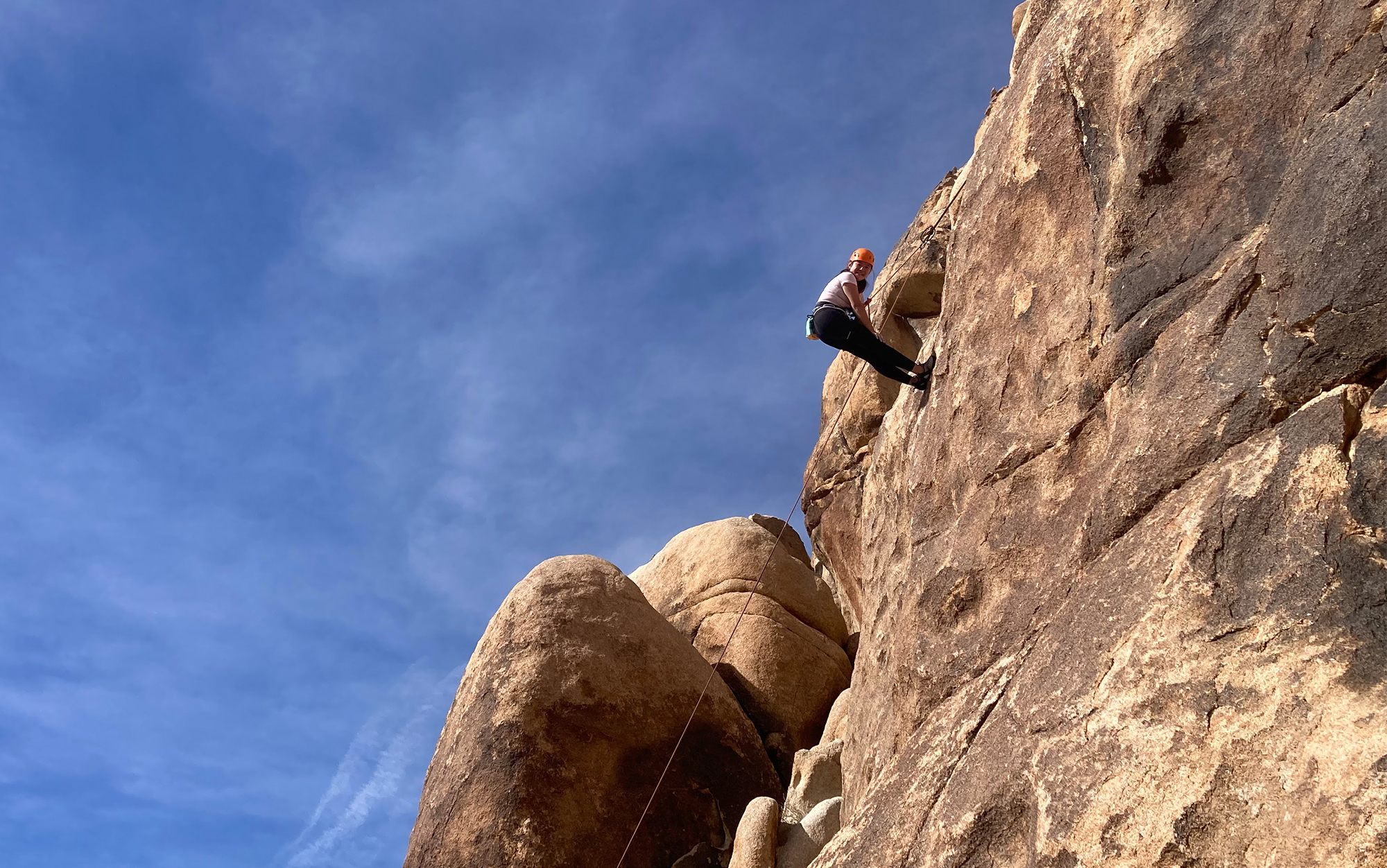
Sean McNally
This harness was by far the most comfortable harness to take falls in and hang around shaking out my arms between burns. Arc’teryx boasts that its Warp Strength Technology spreads the load of a fall around the entire waist belt of the harness and I can attest that while taking lead falls in the range of 10 feet, I noticed the difference. The straps that comprise the waist and leg loops are also extremely thin and wide which makes for comfortable hanging instead of creating pressure points.
While hanging in your harness for a long time is more associated with rock climbing than ice climbing, hanging belays and top roping can be part of ice climbing as well. So the ice clipper slots make this a reasonably versatile cragging harness as it can be used for rock or ice climbing.
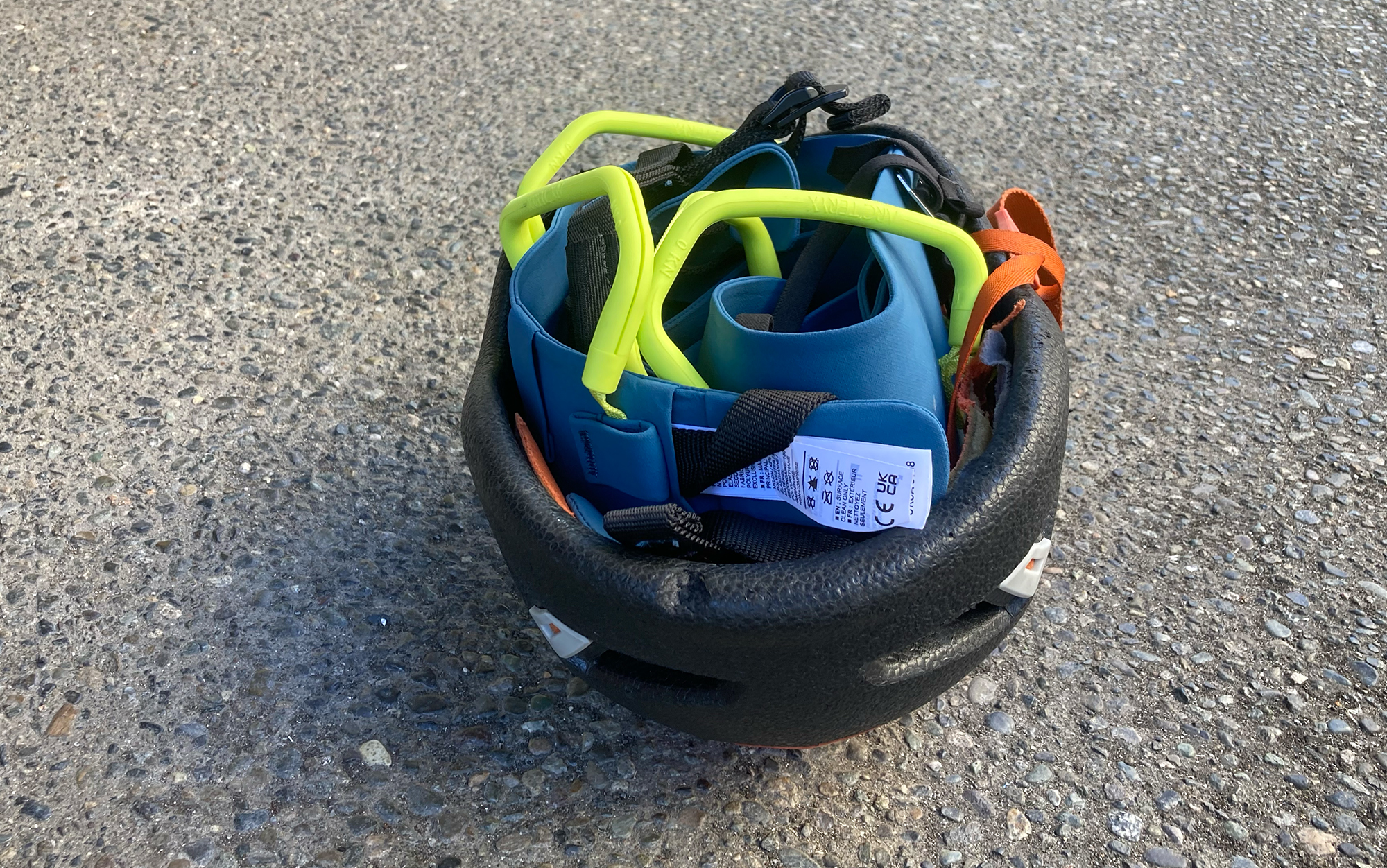
Sean McNally
The trade off with this harness is that it’s not exactly light or packable. The wide straps can make it a little clunky to stuff into a backpack and it doesn’t wrap up into a helmet well. If streamlined weight savings is what you’re after, you may want to go in a different direction. But if you want something that’s going to be friendly to you while you’re hucking kilonewtons around, I can’t recommend the 395a enough.
Read Next: Best Climbing Pants
Best for Multi-Pitch: Petzl Sitta
Key Features
- 290 g
- Five gear loops
- Two ice clipper slots
Pros
- Extremely packable for a technical harness
- Five gear loops makes for great gear organization on long days
- Good balance between lightweight and comfort
Cons
- Leg loops aren’t adjustable
- Falling multiple times can get uncomfortable
High speed, low drag. That’s how I would describe the Petzl Sitta. This harness is made for climbers who plan to move instead of fall or hang, which is why it’s an excellent tool for the send attempt on your project or the stack of long pitches you’ve got to burn through on that big multi-pitch.
The Sitta has the look of other technical climbing harnesses but clocks in quite a bit lighter, giving you the extra edge when trying to defy gravity. The fifth gear loop in the back allows extra room for racking all the gear that multi-pitch climbs require but when not loaded with gear, the Sitta is remarkably low profile.
The Sitta easily folds up and fits right into a helmet. I almost thought I’d received the wrong harness when I took it out of the box, as the Sitta is only slightly bulkier than the Altitude when both are in a stuff sack.
The Sitta is comfortable enough when loaded but after a few falls with hanging in between, I started to feel uncomfortable pressure points around my waist and thighs. The leg loops on this harness are also fixed instead of fully adjustable. While the leg loops stretch to provide some variance in fit, not having fully adjustable leg loops means paying close attention to your thigh width when ordering your size.
How to Choose the Best Climbing Harness
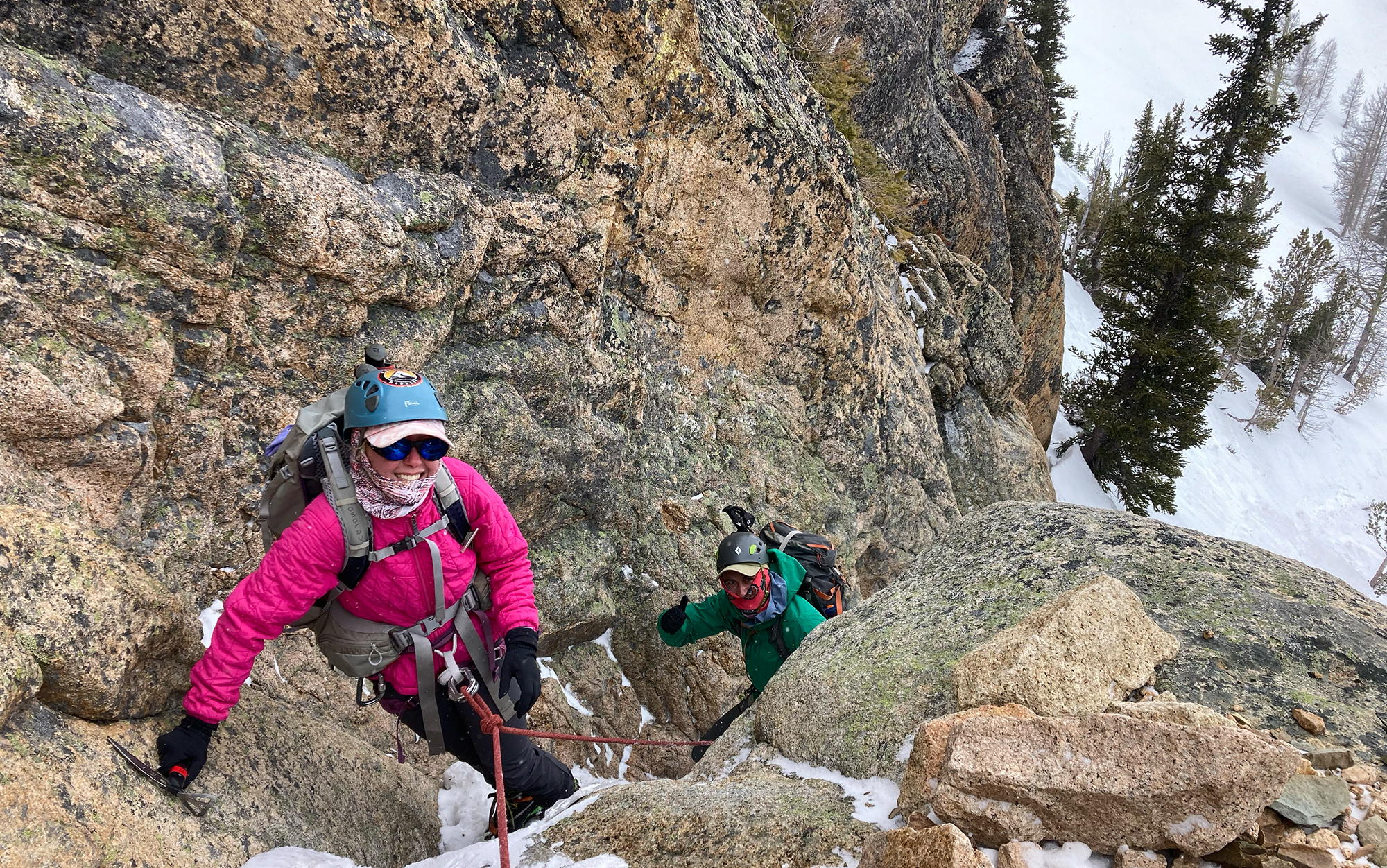
Sean McNally
As stated before, as long as you’re buying through a reputable manufacturer, harnesses should all be UIAA tested and safe for climbing use. This means that purchasing decisions will come down to preferences, fit, and preferred style. Here are a few considerations when deciding on the best harness for you.
Style
There’s a reason that manufacturers claim their harnesses are good for multiple styles of climbing. The reality is that a good generic harness, while maybe not optimized for a specific climbing category, will work just fine across multiple disciplines. So if you’re buying your first harness or if you are someone who likes climbing in all its forms (or even just a few of them), it may be a smart move to buy one harness that can be your cragging harness and your multipitch harness and your alpine harness.
Fit
A harness should move with you while you climb and shouldn’t ever feel like it’s fighting you or pinching you. Try a harness on in person and go through some movement with it before you buy. I personally always have to buy harnesses with adjustable leg loops because my thighs are consistently too big for harnesses with sewn leg loops.
Get the fit right, no matter the suggested gender. Women’s harnesses consistently have larger leg loops than men’s harnesses, even if the waist dimensions are the same. So look at the dimensions of the harness in both genders before buying. More than once, I’ve found a harness I like and bought the women’s version because the leg loops fit me better — you just have to be OK with the pink, purple, or teal color options.
Features
A lot of harness marketing will center around the idea that you won’t even notice it’s on. If that’s true, great. But there’s a difference between not noticing and simply ignoring. Once you buy a harness it’s likely you’ll have to replace it in three to five years, so pay attention to what you like about the harness and what you wish was different so that the next go around you have some specific things that you’ll be looking for.
After a few rounds of purchasing, you’ll likely have a good idea of what you’re looking for to suit your style of climbing, future objectives, and what gear you’re regularly racking on it. Before too long, your collection will be like formal wear, a harness for every occasion.
FAQs
Most harnesses will come with a minimum of four gear loops (two on each side) as that is a sufficient amount of space to efficiently rack gear for a climb. Generally, I like to split my rack (quickdraws, cams, nuts, etc.) between the front two gear loops on the right and left side. This allows me to quickly get to the protection with either hand while I’m actually climbing. Then I like to put other gear on my back two loops such as extra slings, anchor building material, belay devices, etc. Some harnesses can have more gear loops which allows for more detailed organization but I’ve found that for the majority of my climbing four gear loops is just fine.
As I mentioned in my purchasing tips, I don’t let the gender of the harness guide my purchase and I have bought a harness advertised as women’s more than a few times because it fit me better. Outside of color scheme, it just comes down to waist and thigh size. Some harnesses have different thigh and waist dimensions between the two gendered models. Generally, a women’s harness will have larger thigh dimensions with similar or smaller waist dimensions than the men’s harness. That’s why I recommend that folks look at both men’s and women’s harnesses when they find a model they like and just go with whichever one fits your body best regardless of how it’s advertised.
The easy answer here is: Replace your harness when it’s damaged. You should always give your harness a quick once over before putting it on just to make sure everything looks good and there isn’t any damage to the stitching or material. There is a general rule that soft goods such as harnesses should be replaced every three to five years. I think that’s a good rule to follow, but remember that it’s just a recommendation. A harness can certainly get damaged to the point that it needs to be retired before three years of use and if all harnesses failed after five years, we’d be hearing about a lot more accidents in the climbing world. So plan for a three to five year retirement for your harnesses but make sure you’re still inspecting it and using your best judgment
Read Next: Best Climbing Shoes
Final Thoughts
It’s starting to feel like we are in the golden age of harness technology and materials these days. Maybe everyone has felt that way up to this point and maybe everyone who follows will as well. The best climbing harnesses are increasingly light, comfortable, and creatively designed, all while maintaining basic strength and safety standards.
As the sport of climbing moves forward with athletes continually pushing the boundaries of what’s possible, it seems that climbing harnesses and gear are keeping pace right alongside them. One of the best climbing harnesses on this list should align with your climbing goals and provide that extra edge in reaching for them.
- Best Overall: Black Diamond Technician
- Best for Technical Alpine Climbing: Blue Ice Choucas Pro
- Best for Mountaineering: Petzl Altitude
- Best for Projecting: Arc’teryx AR-395a
- Best For Multi-Pitch: Petzl Sitta
The post The Best Climbing Harnesses of 2024, Tested and Reviewed appeared first on Outdoor Life.
Source: https://www.outdoorlife.com/gear/best-climbing-harnesses/
